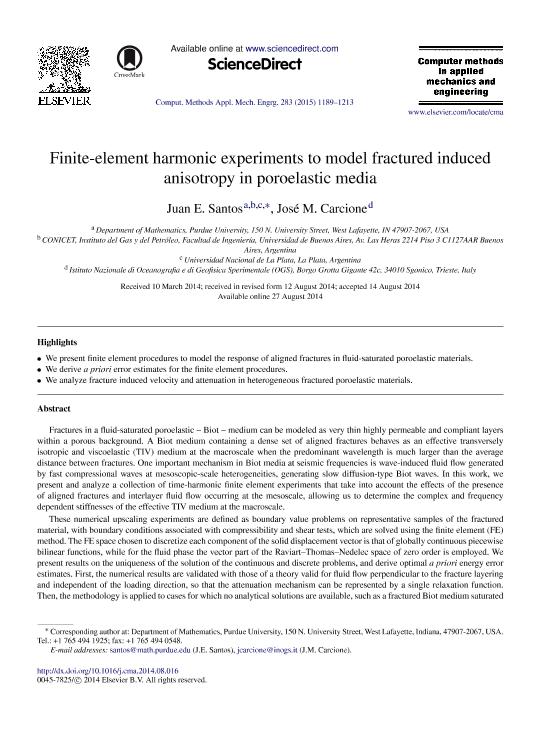Mostrar el registro sencillo del ítem
dc.contributor.author
Santos, Juan Enrique

dc.contributor.author
Carcione, Jose M.

dc.date.available
2018-03-02T18:42:48Z
dc.date.issued
2015-01
dc.identifier.citation
Santos, Juan Enrique; Carcione, Jose M.; Finite-element harmonic experiments to model fractured induced anisotropy in poroelastic media; Elsevier; Computer Methods in Applied Mechanics and Engineering; 283; 1-2015; 1189-1213
dc.identifier.issn
0045-7825
dc.identifier.uri
http://hdl.handle.net/11336/37682
dc.description.abstract
Fractures in a fluid-saturated poroelastic-Biot-medium can be modeled as very thin highly permeable and compliant layers within a porous background. A Biot medium containing a dense set of aligned fractures behaves as an effective transversely isotropic and viscoelastic (TIV) medium at the macroscale when the predominant wavelength is much larger than the average distance between fractures. One important mechanism in Biot media at seismic frequencies is wave-induced fluid flow generated by fast compressional waves at mesoscopic-scale heterogeneities, generating slow diffusion-type Biot waves. In this work, we present and analyze a collection of time-harmonic finite element experiments that take into account the effects of the presence of aligned fractures and interlayer fluid flow occurring at the mesoscale, allowing us to determine the complex and frequency dependent stiffnesses of the effective TIV medium at the macroscale.These numerical upscaling experiments are defined as boundary value problems on representative samples of the fractured material, with boundary conditions associated with compressibility and shear tests, which are solved using the finite element (FE) method. The FE space chosen to discretize each component of the solid displacement vector is that of globally continuous piecewise bilinear functions, while for the fluid phase the vector part of the Raviart-Thomas-Nedelec space of zero order is employed. We present results on the uniqueness of the solution of the continuous and discrete problems, and derive optimal a priori energy error estimates. First, the numerical results are validated with those of a theory valid for fluid flow perpendicular to the fracture layering and independent of the loading direction, so that the attenuation mechanism can be represented by a single relaxation function. Then, the methodology is applied to cases for which no analytical solutions are available, such as a fractured Biot medium saturated with brine and patches of CO2 and a brine saturated sample of uniform background and fractures with fractal variations in their petrophysical properties.
dc.format
application/pdf
dc.language.iso
eng
dc.publisher
Elsevier

dc.rights
info:eu-repo/semantics/openAccess
dc.rights.uri
https://creativecommons.org/licenses/by-nc-sa/2.5/ar/
dc.subject
Anisotropy
dc.subject
Attenuation
dc.subject
Finite Elements
dc.subject
Fractures
dc.subject
Poroelasticity
dc.subject
Velocity Dispersion
dc.subject.classification
Meteorología y Ciencias Atmosféricas

dc.subject.classification
Ciencias de la Tierra y relacionadas con el Medio Ambiente

dc.subject.classification
CIENCIAS NATURALES Y EXACTAS

dc.title
Finite-element harmonic experiments to model fractured induced anisotropy in poroelastic media
dc.type
info:eu-repo/semantics/article
dc.type
info:ar-repo/semantics/artículo
dc.type
info:eu-repo/semantics/publishedVersion
dc.date.updated
2018-03-02T14:18:29Z
dc.journal.volume
283
dc.journal.pagination
1189-1213
dc.journal.pais
Países Bajos

dc.journal.ciudad
Amsterdam
dc.description.fil
Fil: Santos, Juan Enrique. Universidad de Buenos Aires. Facultad de Ingeniería. Instituto del Gas y del Petróleo; Argentina. Purdue University; Estados Unidos. Consejo Nacional de Investigaciones Científicas y Técnicas; Argentina
dc.description.fil
Fil: Carcione, Jose M.. Istituto Nazionale di Oceanografia e di Geofisica Sperimentale; Italia
dc.journal.title
Computer Methods in Applied Mechanics and Engineering

dc.relation.alternativeid
info:eu-repo/semantics/altIdentifier/doi/http://dx.doi.org/10.1016/j.cma.2014.08.016
dc.relation.alternativeid
info:eu-repo/semantics/altIdentifier/url/https://www.sciencedirect.com/science/article/pii/S0045782514002862
Archivos asociados
